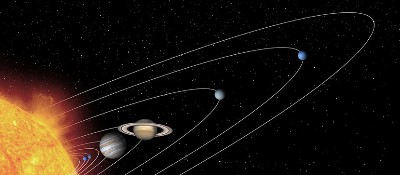 
J. Marvin Herndon's Origin of Earth's Magnetic Field |
|
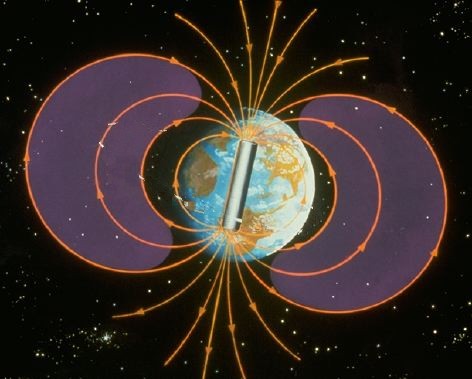 No other manifestation of Earth has been as seemingly inexplicable as the Earth’s magnetic field. Albert Einstein is said to have considered its origin one of the most important unsolved problems in physics. More than a thousand years ago, individuals in China set afloat in bowls of water tiny slivers of loadstone, the mineral now called magnetite, and discovered that the slivers quickly assumed a preferred direction. That observation led to the development of the magnetic compass.
In 1838, the mathematical genius, Johann Carl Friedrich Gauss, proved that the Earth’s magnetism source is at, or very near, the center of the Earth [2].
In 1919, Larmor suggested that the Sun’s magnetic field might be sustained by a mechanism similar to a self-exciting dynamo [3]. Elsasser [4-6] and Bullard [7] first adapted the solar dynamo concept to explain the Earth’s magnetic field being generated by a dynamo-like action in the Earth’s fluid core. The dynamo mechanism is essentially a magnetic amplifier. Since 1939, the geomagnetic field has been believed to originate by convective motions in the Earth’s fluid, electrically-conducting core. The idea is that the convective fluid interacts with the Coriolis forces produced by planetary rotation and acts like a dynamo which is a magnetic amplifier [8]. The idea seemed so logical and seemed to make such sense in explaining the origin of the observed geomagnetic field that for decades no one seriously questioned whether long-term, sustained convection could in fact really occur in Earth’s fluid core. Then along came J. Marvin Herndon who, not only questioned it, but discovered two reasons that convection is physically impossible in the Earth's fluid core [9-11].
“The simplest example of thermally induced convection arises when a horizontal layer of fluid is heated from below and an adverse temperature gradient is maintained. The adjective ‘adverse’ is used to qualify the prevailing temperature gradient, since, on account of thermal expansion, the fluid at the bottom becomes lighter than the fluid at the top; and this is a top-heavy arrangement which is potentially unstable. Under these circumstances the fluid will try to redistribute itself to redress this weakness in its arrangement. This is how thermal convection originates: It represents the efforts of the fluid to restore to itself some degree of stability.”
For stable convection to exist for extended periods of time in the Earth’s fluid core, it is necessary that an adverse temperature gradient be maintained for extended periods of time so that heat produced beneath the fluid core will cause the fluid at the bottom of the core to be lighter, more buoyant, making it rise to the top of the core, bringing the heat with it. To maintain that “adverse temperature gradient” for extended periods of time requires the temperature at the top of the fluid core to be maintained at a lower temperature than at the bottom of the fluid core. The top of the fluid core can only remain cooler than the bottom of the core if the heat brought to top by convection and by thermal conduction can be efficiently removed. And, therein lays one problem. The Earth’s fluid core is wrapped in an insulating blanket, a rock shell, the mantle, that is 2900 km thick, and which has a considerably lower heat capacity and lower thermal conductivity than the fluid core. Thus heat brought to the top of the core cannot be efficiently removed by thermal conduction. In other words, in the fluid core, an adverse temperature gradient cannot be maintained for extended periods of time, and thus convection cannot be sustained for extended periods of time [9-10]. But, as Herndon discovered, there is another, even more serious, reason that convection is physically impossible in the Earth's fluid core. Because of the over-burden weight, the Earth’s core is about 23% more dense at the bottom than at the top. The tiny, tiny amount of thermal expansion at the bottom cannot make the Earth’s core top-heavy and cannot cause a thermally-expanded “parcel” from the bottom to float to the top of the core as required for convection. Thus, the Earth’s core cannot engage in convection [11]. So, the implication is quite
clear: Either the geomagnetic field
is generated by a process other than
the convection-driven dynamo-mechanism, or there
exists another fluid region within
the deep-interior of Earth which can
sustain convection for extended
periods of time. The latter appears
to be the case. In 1993, J. Marvin Herndon published the first of a series of scientific articles revealing the background, feasibility and evidence of a nuclear fission reactor, called the georeactor, at the center of the Earth as the energy source for the geomagnetic field [9-11,13-20], which, as Rao notes with extensive references [21], may offer the solution to the riddles of geomagnetic field variability and deep-Earth helium production. The calculations underlying Herndon’s georeactor concept have been verified [22] and extensive numerical simulations have been conducted at Oak Ridge National Laboratory [17, 18] and using computer software licensed there from [19, 20].
It is expected that convective motions within the electrically conducting fluid (or slurry) sub-shell will interact with the Coriolis forces produced by planetary rotation and act like a dynamo, a magnetic amplifier, as illustrated at right. And, unlike in Earth’s fluid core, the georeactor sub-shell contains large amounts of neutron-rich radioactive fission-produced elements which beta decay yielding electrons for generating magnetic seed-fields for amplification. The georeactor unit thus acts as both the energy source and the operant fluid for generating the Earth’s magnetic field by dynamo action. Even though variations in nuclear fuel occur over time, Herndon's georeactor uniquely is expected to be self-regulating through establishing a balance between heat-production and actinide settling-out [11]. In the micro-gravity environment at the center of Earth, georeactor hear production that is too energetic would be expected to cause actinide sub-core disassembly, mixing actinide elements with neutron-absorbers of the sub-shell, quenching the nuclear fission chain reaction. But as the denser actinide elements begin to settle-out of the mix, the chain reaction would re-start, ultimately establishing a balance, an equilibrium between heat-production and actinide settling-out, a self-regulating mechanism.
The Earth's
magnetic field has been decreasing in intensity over the past hundred
years. Moreover, as shown in the figure at left, the North Magnetic Pole
has recently moved at a rapid rate toward Siberia. These observations
are taken by some as a possible indication of a forth-coming magnetic
reversal, potentially the first in some 700,000 years.
Magnetized surface areas of Mars and the Moon indicate the former existence of internally generated magnetic fields in those bodies. J. Marvin Herndon has presented evidence attesting to the commonality of matter in the Solar System, which is like that of the deep-interior of Earth, and has made the suggestion [19, 22] that planetary magnetic fields generally arise from the same georeactor-type mechanism which Herndon [9-11] has suggested generates and powers the Earth’s magnetic field. YouTube Video: Origin of Earth's Magnetic Field (click here) This video is best "watched in high quality" as it contains an experimental demonstration of why long-term convection, and hence dynamo-action, in the fluid core is impossible. |
| References | |
| 1. | Gilbert, W., De Magnete. 1600, London: Peter Short. 240. |
| 2. | Gauss, J. C. F., Allgemeine Theorie des Erdmagnetismus: Resultate aus den Beobachtungen des magnetischen Vereins in Jahre 1838. 1838, Leipzig. 73. |
| 3. | Larmor, J., Re. Brit. Assn., 1919. 159. |
| 4. | Elsasser, W. M., On the origin of the Earth's magnetic field. Physical Review, 1939. 55, 489-498. |
| 5. | Elsasser, W. M., Induction effects in terrestrial magnetism. Physical Review, 1946. 69, 106-116. |
| 6. | Elsasser, W. M., The Earth's interior and geomagnetism. Reviews of Modern Physics, 1950, 22, 1-35. |
| 7. | Bullard, E. C., The magnetic flux within the Earth. Proceedings of the Royal Society of London, 1949. A197, 433-453. |
| 8. | Buffett, B. A., Earth's core and the geodynamo. Science, 2000. 288: p. 2007-2013. |
| 9. | Herndon, J. M., Nuclear georeactor generation of the Earth's geomagnetic field. Current Science, 2007, 93, 1485-1487. (click here for pdf) |
| 10. | Herndon, J. M., Maverick's Earth and Universe. 2008, Vancouver: Trafford Publishing. ISBN 978-1-4251-4132-5. |
| 11. | Herndon, J. M., Uniqueness of Herndon's georeactor: Energy source and production mechanism for Earth's magnetic field. arXiv:0901.4509 28 Jan 2009. (click here for pdf) |
| 12. | Chandrasekhar, S., Thermal Convection. Proceedings of the American Academy of Arts and Sciences, 1957. 86(4), 323-339. |
| 13. | Herndon, J. M., Feasibility of a nuclear fission reactor at the center of the Earth as the energy source for the geomagnetic field. Journal of Geomagnetism and Geoelectricity, 1993, 45, 423-437. (click here for pdf) |
| 14. | Herndon, J. M., Planetary and protostellar nuclear fission: Implications for planetary change, stellar ignition and dark matter. Proceedings of the Royal Society of London, 1994, A455, 453-461. (click here for pdf) |
| 15. | Herndon, J. M., Sub-structure of the inner core of the Earth. Proceedings of the National Academy of Sciences USA, 1996, 93, 646-648. (click here for pdf) |
| 16. | Herndon, J. M., Examining the overlooked implications of natural nuclear reactors. Eos, Transactions of the American Geophysical Union, 79, 451, 456. (click here for pdf) |
| 17. | Hollenbach, D. F. and Herndon, J. M., Deep-Earth reactor: Nuclear fission, helium, and the geomagnetic field. Proceedings of the National Academy of Sciences USA, 2001, 98, 11085-11090. (click here for pdf) |
| 18. |
Herndon, J. M., Nuclear georeactor origin of oceanic basalt 3He/4He, evidence, and implications. Proceedings of the National Academy of Sciences USA, 2003, 100, 3047-3050. (click here for pdf) |
| 19. | Herndon, J. M., Solar System processes underlying planetary formation, geodynamics, and the georeactor. Earth, Moon, and Planets, 2006, 99(1), 53-99. (click here for pdf) |
| 20. | Herndon, J. M. and Edgerley, D. A., Background for terrestrial antineutrino investigations: Radionuclide distribution, georeactor fission events, and boundary conditions on fission power production. arXiv:hep-ph/0501216 24 Jan 2005. (click here for pdf) |
| 21. | Rao, K. R., Nuclear reactor at the core of the Earth! - A solution to the riddles of relative abundances of helium isotopes and geomagnetic field variability. Current Science, 2002, 82(2), 126-127. |
| 22. | Seifritz, W., Some comments on Herndon's nuclear georeactor. Kerntechnik, 2003, 68(4), 193-196. |
| 22. | Herndon, J. M., Nature of planetary matter and magnetic field generation in the Solar System. Current Science, 2009, 96, 1033-1039. (click here for pdf) |

 The Earth acts like a giant magnet
with a magnetic field extending into
interplanetary space, shielding the
planet by deflecting charged
particles of the solar wind, as
illustrated at right, but it
is not a permanent magnet. Inside Earth is too hot (above
the Curie point) for a permanent
magnet to remain magnetized.
Moreover, the Earth’s magnetic field
must continuously be fed with
energy; otherwise its interactions
with the solar wind and with matter
in the Earth would cause it to decay
and eventually disappear. Thus,
there must exist at or near the
Earth’s center a mechanism for
generating the geomagnetic field and
an energy source for powering it.
The Earth acts like a giant magnet
with a magnetic field extending into
interplanetary space, shielding the
planet by deflecting charged
particles of the solar wind, as
illustrated at right, but it
is not a permanent magnet. Inside Earth is too hot (above
the Curie point) for a permanent
magnet to remain magnetized.
Moreover, the Earth’s magnetic field
must continuously be fed with
energy; otherwise its interactions
with the solar wind and with matter
in the Earth would cause it to decay
and eventually disappear. Thus,
there must exist at or near the
Earth’s center a mechanism for
generating the geomagnetic field and
an energy source for powering it.
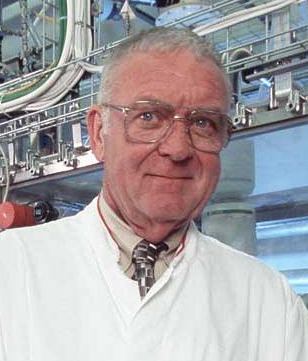
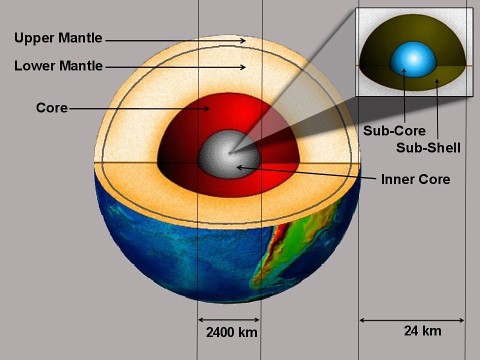

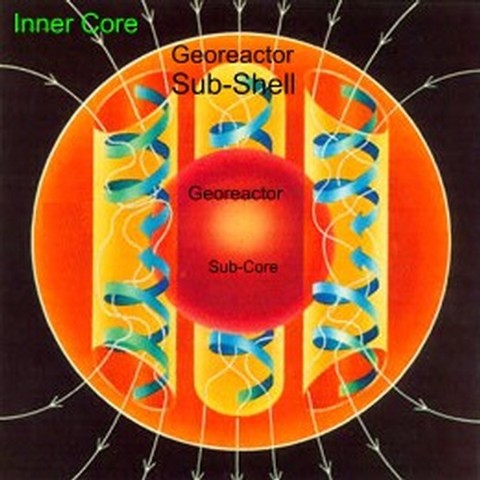
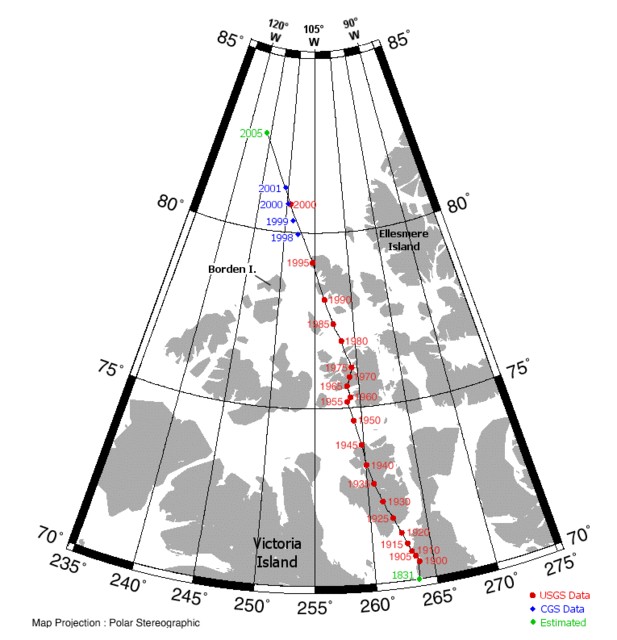 Because
of the self-regulation mechanism, the periods of long-term stable
magnetic field production lasting 40+ million years, the so-called "superchrons",
are expected. But, what then causes magnetic reversals?
Because
of the self-regulation mechanism, the periods of long-term stable
magnetic field production lasting 40+ million years, the so-called "superchrons",
are expected. But, what then causes magnetic reversals?